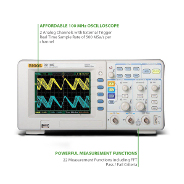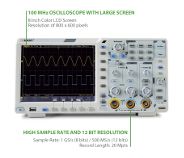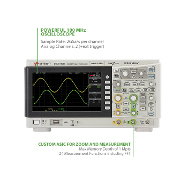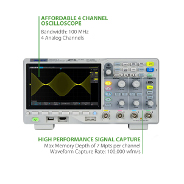BEST 100 MHz OSCILLOSCOPES

INTRODUCTION:
100 MHz Digital Oscilloscopes are a good entry level oscilloscope for hobbyists and engineers doing basic troubleshooting of their circuit design. While technically the scope can measure up to 100 MHz frequency signals, we know from how to select the best scope that if you are really trying to diagnosis an issue with your circuit this is only good for signals up to 20 MHz. Beside 20 MHz signals these class of scopes are good for troubleshooting basic TTL signal systems.
We have broken down the Best 100 MHz Oscilloscopes into 3 groups. Best scope under $500 USD these scopes would be great for the engineer on a low budget. For engineers with a little more budget and demanding applications we have the best oscilloscopes for budgets up to $1000 USD. Finally, for projects requiring capturing more than 1 or 2 signals we have a recommended 4 channel oscilloscope. To view all 100 MHz Oscilloscopes.
QUICK NAVIGATION:
- BEST 100 MHz OSCILLOSCOPE UNDER $500 USD
- BEST 100 MHz OSCILLOSCOPE UP TO $1000 USD
- BEST 100 MHz 4 CHANNEL OSCILLOSCOPE


The RIGOL Technologies DS1102E is an affordable 100 MHz 2 channel digital oscilloscope. The oscilloscope offers 20 waveform measurements with 3 additional cursor measurements. The built in FFT cursor measurement is a great added feature in this budget 100 MHz oscilloscope. The RIGOL screen size is only 5.6 inches which if you are trying to display several measurements could make it hard to read but the DS1102E does offer remote interface including USB and RS-232. For the price and performance, it is hard to find a better 100 MHz oscilloscope.

The 100 MHz Oscilloscope offered by OWON Technology has amazing features for an oscilloscope offered under $500 USD. To start this oscilloscope has the ability to provide 12 bit resolution at 500 MSa/s rate and for engineers needing a higher sample rate the scope can provide 1 GSa/s but the resolution is reduced to 8 bits. The large 8 inch LCD screen with 800 x 600 resolution is great for viewing your signal and with the built in VGHA out you can easily show the signal on a larger screen. Other great features of this OWON XDS2102A include multiple triggers and bus decoding functions.


Keysight DSOX1102A with DSOX1B7T102 100 MHz upgrade offers superior features for an oscilloscope well under $1,000. The 2 GSa/s and 1 Mpts of memory depth makes this oscilloscope the best in class of entry level oscilloscopes. Plus Keysight has used it’s custom ASIC chip to provide this entry level oscilloscope the MegaZoom feature for detail analysis and viewing of your signals. In the box you will find 200 MHz oscilloscope probes; which is a nice addition compared to other budget 100 MHz oscilloscsope. If you budget will support the higher price point it is hard to beat the Keysight DSOX1102A.


The Siglent SDS1104X-is a 4 channel 100 MHz oscilloscope at an affordable price for the feature set provided. To start the 4 channel oscilloscope offers 500 MSa/s sample rate when all channels are enabled and 1 GSa/s sample rate when half the channels are used. The 7 Mpts per channel memory depth and 100,000 wfm/s waveform capture rate will ensure you can catch those hard to find transient events. Other great features of this 100 MHz oscilloscope include 38 measurement functions and easy to use front panel. The input/output includes USB Host, USB Device, LAN, Pass/Fail, Trigger Out, and optional Sbus (Siglent MSO). The large 7 inch LCD display will allow you to easy display the 4 analog channels and measurement functions.
FACTORS WE USED FOR OUR RECOMMENDATIONS:
Before we list the technical criteria used in determining the recommended 100 MHz Oscilloscopes, we should mention that everyone on our staff is either an electrical engineer or a physicist with over 10 years of experience. Our recommendation process includes an in-depth review of 8 different key attributes for each product:
- 1. The bandwidth of the oscilloscope must be at least 100 MHz.
- 2. The sample rate and available memory in the oscilloscope to capture and measure the signal
- 3. On board measurement functions including can the oscilloscope take FFT measurements
- 4. How well the oscilloscope front panel was laid out to provide for quick setup and display size to show multiple measurements.
- 5. Quality of the operating manual and support documentation
- 6. Reputation and core focus of the manufacturer as well as the number of years the manufacturer has been in business.
- 7. Availability of LabVIEW drivers or control software when a PC interface is available.
- 8. Price and availability.






